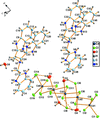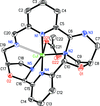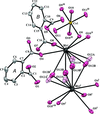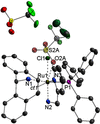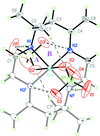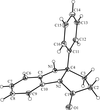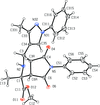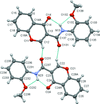issue contents
August 2013 issue

Cover illustration: A positive deformation density isosurface (0.009 e Å-3) for methyl (±)-(1S,2S,3R)-2-methyl-1,3-diphenylcyclopropanecarboxylate, viewed in the plane of the ring. See Bacsa & Briones [Acta Cryst. (2013), C69, 910-914].
scientific comment
A detailed analysis of the reporting of absolute structure has been undertaken on all the non-centrosymmetric crystal structures published in Acta Crystallographica Section C between January 2011 and November 2012.
Some reported structures fail to include all possible donor–acceptor close contacts, or to seek H-atom electron densities associated with apparent D—H⋯A trios. The relevant issues are illustrated with three published examples in the hope of slowing the proliferation of these problems, with the scientifically desirable goal of improving the accuracy of crystallographic models while also providing improved search keys for information retrieval.
metal-organic compounds
Download citation


Download citation


The structure of the anion is a novel chloride-bridged pentanuclear cluster. The five unique CdII centres have quite different coordination environments.
Download citation


Download citation


The central Na+ cation exhibits distorted octahedral coordination geometry involving two deprotonated O atoms, two hydroxy O atoms and two double-bonded O atoms of the bisphosphonate anion. Pairs of sodium-centred octahedra share edges and the pairs are in turn connected to each other by the biphosphonate anion to form a two-dimensional network parallel to the (001) plane.
Download citation


Download citation


Reaction of a newly synthesized 3-(3,5-dicarboxybenzyloxy)benzoic acid ligand with zinc ions yielded a single-framework metal–organic coordination polymer (MOF) of attractive architecture.
Download citation


Download citation


The coordinating properties of the novel ligand 4′-[4-(pyrimidin-5-yl)phenyl]-2,2′:6′,2′′-terpyridine were tested by reacting it with cadmium(II) nitrate. The resulting title complex presents a supramolecular motif dominated by a significant number of π–π interactions involving all the aromatic rings.
Download citation


Download citation


In the title coordination polymer, each AgI cation has a distorted tetrahedral geometry coordinated by three of the four carboxylate O atoms and the S atom from symmetry-related sulfanediyldiacetate ligands. The bridging sulfanediyldiacetate groups lead to a two-dimensional layer structure and the layers are interconnected via Ag—S bonds.
Download citation


Download citation


The title structure contains two kinds of independent one-dimensional chain, viz. {[Cd(C8H15N2O2)Cl2]+}n and {[CdCl3(H2O)]−}n, and uncoordinated water molecules. Each CdII cation in the former chain is octahedrally coordinated by two pairs of bridging chloride ligands and two O atoms from different bridging carboxylate groups, while CdII cations in the latter chain are octahedrally surrounded by four bridging chloride ligands, one terminal chloride ligand and one coordinated water molecule.
Download citation


Download citation


The structural unit consists of one C2-symmetric [NbOF4]− anion, where the NbV centre is five-coordinated by four F atoms and one O atom in the first coordination shell, forming a square-pyramidal coordination geometry, and of one centrosymmetric coordinated [Cu2(obpy)2]+ cation (obpy is 2,2′-bipyridin-6-olate), in which the oxidation state of each Cu site is disordered, which is confirmed by XPS results.
Download citation


Download citation


Transmetallation of a barium [2+2] Schiff base macrocycle with copper(II) results in three successive ring contractions, reducing the ring size from 20 to 16 members. Unusually, the contraction does not appear to result in an improved `fit' for the copper(II) ion.
Download citation


Download citation


The Rb+ cation is surrounded by nine O atoms from Hpht− anions and water molecules, with a strongly deformed pentagonal–bipyramidal geometry and one apex split into three positions. The crystal packing is governed by numerous hydrogen bonds involving all water molecules and Hpht− anions.
Download citation


Download citation


This paper gives an account of a procedure to establish the identity of a ligand in an Ru complex and to refine two instances of positional and compositional disorder in the ligand and a counter-ion.
Download citation


Download citation


The title complex is composed of two deprotonated N,N′-bidentate 2-[(phenylimino)ethyl]-1H-pyrrol-1-ide ligands around a central NiII cation, with the pyrrolide rings and imine groups lying trans to each other. Molecules are linked into simple chains by two C—H⋯π hydrogen bonds, one of which is intermolecular with a phenyl β-C atom as donor, while the other is intramolecular with a pyrrole β-C atom as donor.
Download citation


Download citation


Two polymorphs contain octahedral [Co(en)3]3+ cations (en is ethylenediamine) and tetrahedral [SbS4]3− anions, which are interconnected via various N—H⋯S hydrogen bonds to form two different types of three-dimensional network.
Download citation


Download citation


The crystal structure determination of this complex revealed the presence of two different anionic species which other spectroscopic methods failed to characterize. The reduced catalytic activity was not fully understood until the crystallographic data provided evidence for the mixed anionic species. The crystal structure of this RuII complex clearly shows that the majority of the synthesized material has a chloride anion present.
Download citation


Download citation


The three title transition-metal complexes display a distorted 4+2 octahedral environment for the cation, with the macrocycle defining the base. The effect of the different axial ligands in the intra- and intermolecular hydrogen bonding is discussed.
Download citation


Download citation


A structure evaluation is presented of a known structure from a merohedrally twinned crystal, together with a re-examination of the previously published models.
Download citation


Download citation


In the title compound, the Pb atom sits on a crystallographic C2 axis and is six-coordinate, ligated by two chelating carboxylate groups from two 3-(pyridin-4-yl)benzoate ligands and by two N atoms from another two benzoate ligands. Each ligand is conformationally chiral and bridges two PbII centres, extending the structure into a corrugated two-dimensional (4,4) net.
Download citation


Download citation


The title AgI coordination polymer is a novel three-dimensional framework involving mixed naphthalene-1,5-disulfonate and aminoacetate ligands. In the crystal structure, each of the three different functional groups (carboxylate, amino and sulfonate) is coordinated to the AgI atoms.
organic compounds
Download citation


Download citation


Molecules of the title compound are linked into chains by intermolecular C=O⋯H—N hydrogen bonds and the chains are weakly interconnected by π–π stacking interactions. A comparison of the geometric parameters of the title molecule and several related benzimidazoles and pyrrolidones is presented.
Download citation


Download citation


The molecules contain an intramolecular π–π stacking interaction, and C—H⋯O and C—H⋯N hydrogen bonds link the molecules to form a bilayer having tert-butyl groups on both faces.
Download citation


Download citation


The title dipeptide, incorporating the nonproteinogenic amino acid residue L-2-aminobutyric acid, forms an extensively disordered, compact crystal packing arrangement in the tetragonal space group I4.
Download citation


Download citation


In the title nucleoside, the N-glycosylic bond exhibits a syn conformation and the pentofuranosyl residue adopts a C2′-endo envelope conformation. The orientation of the exocyclic C4′—C5′ bond is +sc (gauche, gauche). The nucleoside forms an ordered and stacked three-dimensional network.
Download citation


Download citation


A new polymorph of bis(2-aminopyridinium) fumarate–fumaric acid (1/1), determined using powder X-ray diffraction data, is described. The similarities and differences in hydrogen bonds between the new and previous polymorph are discussed in order to understand the polymorphism of the title salt.
Download citation


Download citation


The conformation of a new TXA2 receptor antagonist, mainly determined by an intramolecular N—H⋯O hydrogen bond, is further explored using the Cambridge Structural Database.
Download citation


Download citation


The crystal structures of three fumarate salts with different substituted anilines are reported. 3-Methylanilinium hydrogen fumarate and 4-chloroanilinium hydrogen fumarate are isostructural resulting in the formation of similar supramolecular architectures.
Download citation


Download citation


The electron density in the title substituted cyclopropane has been determined by refining single-crystal X-ray data using scattering factors derived from quantum mechanical calculations. Topological analysis of the electron densities in the three cyclopropane C—C bonds was carried out and shows the effects of substitution on these C—C bonds.
Download citation


Download citation


Two very closely related pyrrolo[3,4-c]pyrrole derivatives form hydrogen-bonded sheets using a different combination of C—H⋯N, C—H⋯O and C—H⋯π interactions.
Download citation


Download citation


The structures of (E)-2-(2-(phenylidene)hydrazinyl)quinoxaline and six Cl and Br derivatives have similar supramolecular structures involving an N—H⋯N hydrogen bond and π–π stacking interactions.
Download citation


Download citation


Two polymorphs of N-(2-methoxyphenyl)-4-oxo-4H-chromone-3-carboxamide crystallise in the monoclinic space group P21/c, each with two molecules in the asymmetric unit. The conformations of all four molecules are similar, the main differences being in their supramolecular interactions.
Download citation


Download citation


The title compound exists in a zwitterionic form. There is a strong intramolecular N—H⋯O hydrogen bond, an intramolecular O—H⋯O hydrogen bond, an intermolecular C—H⋯O contact and π–π stacking interactions, resulting in a three-dimensional network.


 journal menu
journal menu













